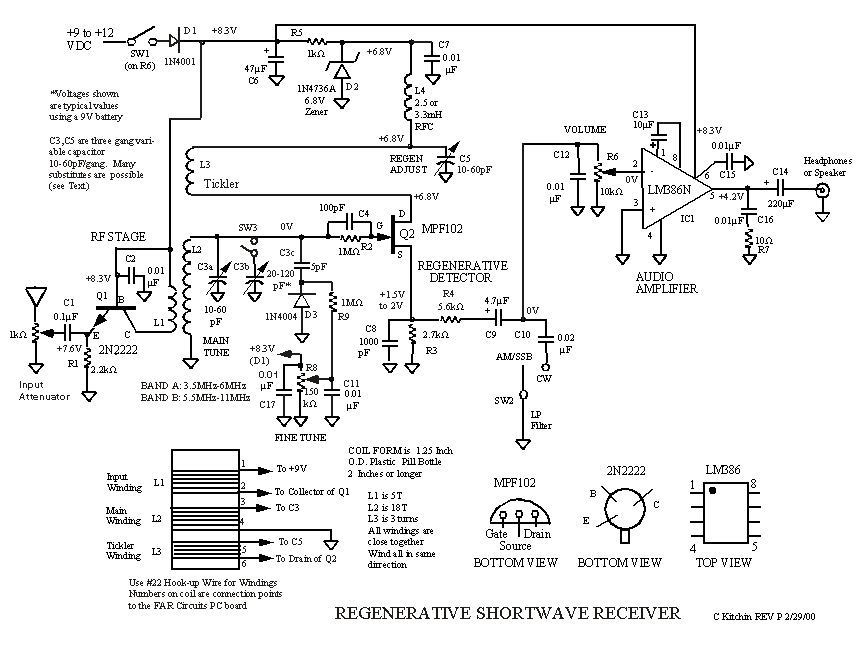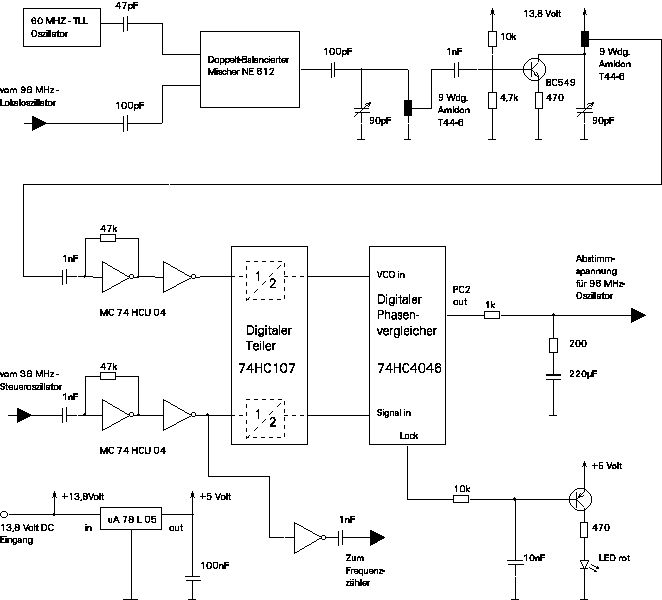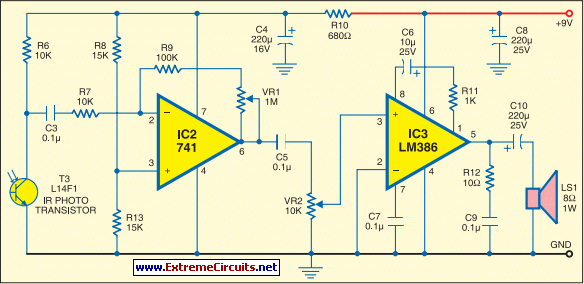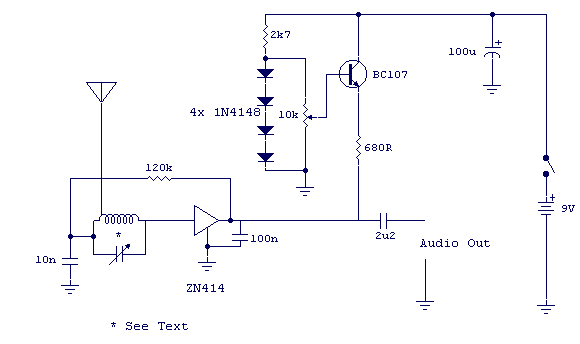
Ir Receiver I
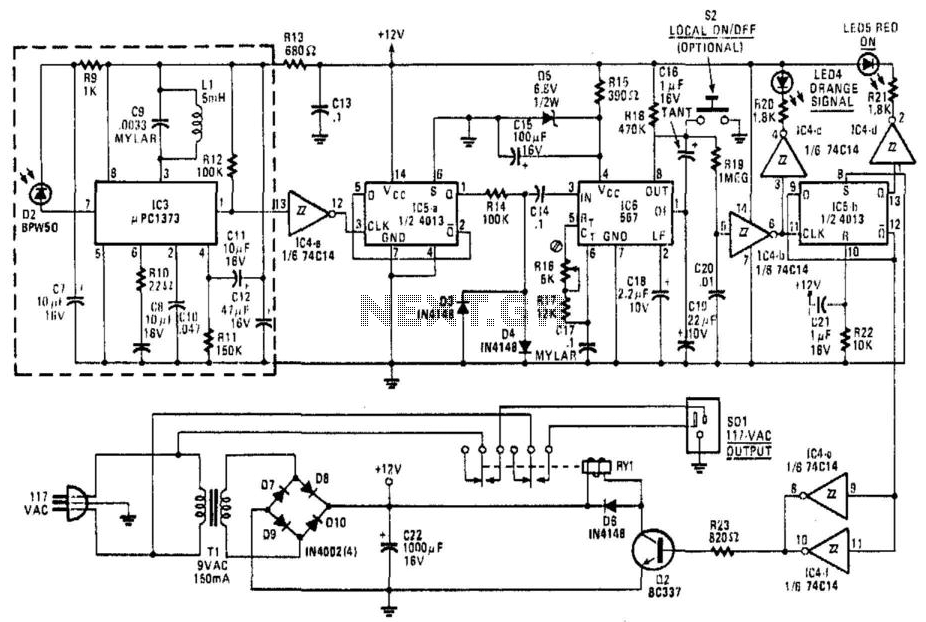
This receiver is designed around a uPC1373 IR remote-control preamplifier, featuring a sensitive 30-to-40 kHz tuned detector, an automatic gain control, a peak detector, and an output waveshaping buffer. The demodulated signal from the preamplifier stage is directed to IC4A, a 74C14 Schmitt trigger. The resulting squared-up 1,500 Hz signal is then transmitted to the clock input of IC5A, which is half of a 4013 dual "D" flip-flop. This generates a 750 Hz signal that is clipped to approximately 0.7 V peak-to-peak by diodes D3 and D4. The clipped signal is subsequently routed to IC6, a 567 tone decoder. The output from this integrated circuit goes low whenever the input frequency aligns with the lock range of its internal voltage-controlled oscillator (VCO). Upon detection of the correct frequency, pin 8 of IC6 goes low. This output signal is processed through another Schmitt trigger (IC4B), which activates another "D" flip-flop, IC5B. Schmitt trigger IC4B also drives IC4C, which in turn controls LED4, SIGNAL, illuminating it whenever a signal is received. The Q output of IC5B drives two parallel-connected inverters. IC4C and IC4F activate transistor Q2 when the Q output goes low, energizing the relay whose contacts switch the controlled device on and off.
The circuit operates effectively as an IR remote control receiver by utilizing the uPC1373 preamplifier to amplify incoming IR signals. The tuned detector is critical for isolating signals within the 30-to-40 kHz range, ensuring that the receiver is sensitive to the modulation frequencies typically used in remote control applications. The automatic gain control feature helps maintain a consistent output level despite variations in the strength of incoming signals, which is essential for reliable operation.
The demodulated signal is processed through a Schmitt trigger (IC4A) to produce a clean square wave, which is then fed into a dual "D" flip-flop (IC5A) to divide the frequency by two, generating a 750 Hz output. The clipping stage involving diodes D3 and D4 ensures that the signal remains within a manageable voltage range for subsequent processing stages.
The 567 tone decoder (IC6) is pivotal for frequency detection, as it determines if the incoming signal frequency matches its internal reference. When a valid signal is detected, it triggers the output to go low, signaling the presence of a valid command from the remote control. This low output is then used to activate additional logic components, including another Schmitt trigger and a second "D" flip-flop (IC5B), which further processes the signal.
The final output from the flip-flop drives a transistor (Q2) that controls a relay, allowing the circuit to switch on or off an external device based on the received IR signal. The inclusion of the LED indicator (LED4) provides visual feedback to the user, confirming the reception of a signal. Overall, this circuit design effectively integrates various components to create a responsive and reliable IR remote control system. This receiver is built around a uPC1373 IR remote-control preamplifier, a sensitive 30-to-40 kHz tuned detector, an automatic gain control, a peak detector, and an output waveshaping buffer. The demodulated signal from the preamp stage is sent to IC4A, a 74C14 Schmitt trigger. The squared-up 1 500-Hz signal is then sent to the clock input of IC5A, half of a 4013 dual "D" flip-flop. That 750-Hz signal is clipped to approximately 0.7-V p-p by diodes D3 and D4. The clipped signal is then fed to IC6, a 567 tone decoder. The output of that IC goes low whenever the frequency of the signal fed to it is within the lock range of its internal VCO.
When IC6 detects a signal of the proper frequency, pin 8 goes low. The output signal is fed through another Schmitt trigger (IC4B), which drives another "D" flip-flop, IC5B. Schmitt trigger IC4B also drives IC4C, which in turn drives LED4, SIGNAL, which lights up whenever a signal is received.
The Q output of IC5B drives two parallel-connected inverters. IC4C and IC4F turn transistor Q2 on when Q goes low. That transistor energizes the relay; its contacts switch the controlled device on and off. 🔗 External reference
The circuit operates effectively as an IR remote control receiver by utilizing the uPC1373 preamplifier to amplify incoming IR signals. The tuned detector is critical for isolating signals within the 30-to-40 kHz range, ensuring that the receiver is sensitive to the modulation frequencies typically used in remote control applications. The automatic gain control feature helps maintain a consistent output level despite variations in the strength of incoming signals, which is essential for reliable operation.
The demodulated signal is processed through a Schmitt trigger (IC4A) to produce a clean square wave, which is then fed into a dual "D" flip-flop (IC5A) to divide the frequency by two, generating a 750 Hz output. The clipping stage involving diodes D3 and D4 ensures that the signal remains within a manageable voltage range for subsequent processing stages.
The 567 tone decoder (IC6) is pivotal for frequency detection, as it determines if the incoming signal frequency matches its internal reference. When a valid signal is detected, it triggers the output to go low, signaling the presence of a valid command from the remote control. This low output is then used to activate additional logic components, including another Schmitt trigger and a second "D" flip-flop (IC5B), which further processes the signal.
The final output from the flip-flop drives a transistor (Q2) that controls a relay, allowing the circuit to switch on or off an external device based on the received IR signal. The inclusion of the LED indicator (LED4) provides visual feedback to the user, confirming the reception of a signal. Overall, this circuit design effectively integrates various components to create a responsive and reliable IR remote control system. This receiver is built around a uPC1373 IR remote-control preamplifier, a sensitive 30-to-40 kHz tuned detector, an automatic gain control, a peak detector, and an output waveshaping buffer. The demodulated signal from the preamp stage is sent to IC4A, a 74C14 Schmitt trigger. The squared-up 1 500-Hz signal is then sent to the clock input of IC5A, half of a 4013 dual "D" flip-flop. That 750-Hz signal is clipped to approximately 0.7-V p-p by diodes D3 and D4. The clipped signal is then fed to IC6, a 567 tone decoder. The output of that IC goes low whenever the frequency of the signal fed to it is within the lock range of its internal VCO.
When IC6 detects a signal of the proper frequency, pin 8 goes low. The output signal is fed through another Schmitt trigger (IC4B), which drives another "D" flip-flop, IC5B. Schmitt trigger IC4B also drives IC4C, which in turn drives LED4, SIGNAL, which lights up whenever a signal is received.
The Q output of IC5B drives two parallel-connected inverters. IC4C and IC4F turn transistor Q2 on when Q goes low. That transistor energizes the relay; its contacts switch the controlled device on and off. 🔗 External reference

